History and Use of the SDR
Ryle, A., 2003. History and Use of the SDR. Reformulation, Autumn, pp.18-21.
CAT is a general therapy, which aims at influencing the highly complex system that is a person or self-system. CAT therapists and their patients create descriptions, which are part of work developing self-reflection. Therapists avoid collusion by not reciprocating and reinforcing dysfunctional roles (the CAT model of transference and counter transference). CAT depends on an adequately complex but memorable and useable way of describing what we are trying to influence. In any therapy concepts are needed to guide acts and comments of the therapist. In CAT the aim is also to provide the patient with new ways of understanding and managing themselves. Tools of this kind are a distinguishing feature of mankind. Physical tools extend physical power. Conceptual tools have a similar function with regard to mental powers. CAT therapy tools are signs for thinking about dysfunctional, unreflected upon procedures.
Vygotsky helps us to understand this process in his account of the internalisation of more complex high-level understandings via shared activity and signs. Once internalised, signs convey meanings, which may operate without reflection and are hence not easily challenged. However, procedural knowledge can be reflected on given the access to appropriate signs. Change involves both conceptual and experiential means to evoke understanding and insight. These are not alternatives; conceptual understanding can make it safer to access feelings, felt experience and new concepts, and to try new behaviours.
SDRs, which now take a more or less conventional form, serve to guide therapist and patient on the therapy journey. Their creation and use provide a coherent account of roles, mood, emotion, acts of thinking, feeling and doing that otherwise feel chaotic and meaningless.
EXAMPLE. Reciprocal Role descriptions are often more powerful than are the Traps, Dilemmas and Snags of early CAT. Both forms may be combined as in the following letter and sequential diagram. “Early in your life you seemed to have learnt that relationships involve critical rejection to which the response is either uncared for guilty, striving or rebellion (RRP and dilemma). When you strive and even achieve, however, you critically reject yourself (SELF MANAGEMENT RRP SELF ATTACKING) and disallow your success (SNAG) and when you rebel you get rejected (INTERPERSONAL RRP). These patterns of relating leave you with a pattern for closeness, which is expressed in three alternative ways (DILEMMA AND SEQUENCES):
- Striving to please the critical other – get used – critically reject yourself.
- Avoid closeness, feel lonely. Both 1 and 2 leave your emotional needs unmet and are a source of depression (MOOD SYMPTOM)
- Risking closeness with an idealised other offered a new experience and you felt profoundly worthwhile but when the relationship ended you were left devastated and this, combined with the depression of 1 and 2, led to the deep sadness expressed in your dream of yourself as a frozen chicken (PATIENT’S METAPHOR) which provoked the depression which brought you to therapy.
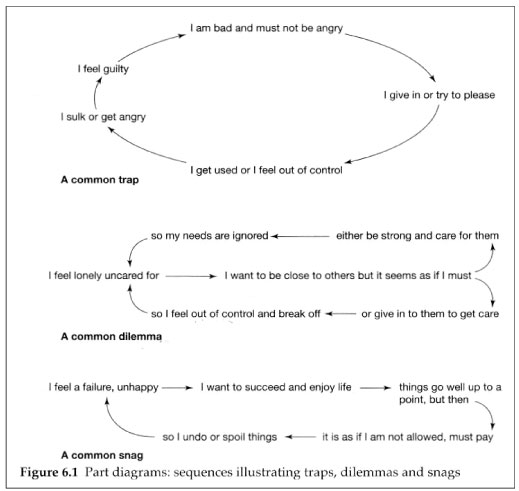 The SDR also suggests how the therapy relationship may develop and what responses you may seek or provoke from me; thus striving and trying to please me in therapy may generate the snag and self-rejection. I may be seen to be critical, provoking rebellion and the fear/certainty of my abandonment may prevent engagement in the therapy, or I may be idealised”.
The SDR also suggests how the therapy relationship may develop and what responses you may seek or provoke from me; thus striving and trying to please me in therapy may generate the snag and self-rejection. I may be seen to be critical, provoking rebellion and the fear/certainty of my abandonment may prevent engagement in the therapy, or I may be idealised”.
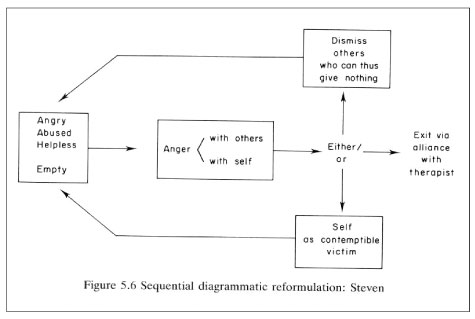 The theme of this paper is to trace the evolution of this kind of diagram.
The theme of this paper is to trace the evolution of this kind of diagram.
How Evolution of SDRs Reflect the Evolution of CAT Theory
Diagrams were tools for thinking which grew out of practice and influence practice. We describe what we can see and deduce from this, but we only see what we can describe. There are different forms of description. Bruner (1986) made the distinction between narrative, which makes experience comprehensible, and paradigmatic descriptions, which provide consistency, verifiability and abstraction. SDRs are paradigmatic; they provide a model of what the patient goes on doing.
CAT initially involved verbal descriptions of dysfunctional, seemingly non-revisable, patterns. Traps, Dilemmas and Snags are more complex descriptions than those of conflicts, irrational beliefs or non-functional behaviours. They include the context and events, knowledge, beliefs and values, acts and consequences, including the responses of others. The advantages are that they are sequential and draw attention to antecedents and consequences.
Two influences lead to the focus on Reciprocal Role Procedures (RRPs). One was psychoanalytical Object Relations theory; the other was the development, many years later, of the Dyad Repertory Grid (Ryle and Lunghi 1970). Mapping the results of the latter provided a visual display of relationship patterns. The Dilemmas, Traps and Snags models emphasised circularity and the self-reinforcing nature of procedures (Map1, Ryle 2002, Fig 6:1 Pg 88). The advantage of these diagrams was the way in which they showed how negative self-reinforcement worked. They were also easy to memorise.
Simple sequential loops could start anywhere but in time it became customary to describe the origin in a core and to show how procedures issuing from the core led back to reinforce it, thus continuing to emphasise the circularity of the original model. The concept of core was, however, unclear. The early diagrams put in a core subjective state or statement of core pain at the centre, seeing this experience as being the source of unsuccessful procedures, following Mann’s emphasis on the patient’s chronically endured pain (Map 2, Ryle 1990, Fig 5.6 Pg 112 ). Situations reminiscent of the original pain could provoke the procedures, which historically had failed to resolve it. In clinical settings alternative modes (exits) could be explored.
The use of the word Core to describe the descriptive centre of the diagram and the deeply felt experience of the patient was liable to be confusing as the developmental and structural understandings of CAT theory placed emphasis on the RRP as the basic unit of description. A clarification was proposed. The core of the diagram was a theoretical abstraction summarising the RRPs evident in the patient’s acts and experiences. Each role described there was likely to be expressed in action and experience, and these were described on the procedural loops
When the diagram’s core was described in terms of core pain it was easy to identify with the child/victim roles and miss the adult derived harming roles. By making the RRPs the centre of the diagram, therapists were alerted to all possible role enactments. In (Map 3,Ryle and Beard 1993, Pg 249) we can see that the diagram is circular and emanates from a core RRP. The advantage of this is that it locates key events and symptoms.
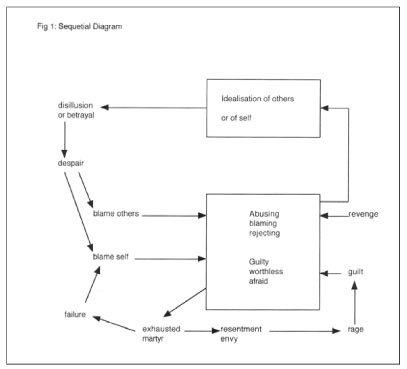
Increasing experience with patients with Borderline Personality Disorder presented difficulties to therapists trying to devise diagrams. This was resolved by the recognition that such patients operate discontinuously. Diagrams were drawn with separate cores, initially most often the ‘Broken Egg’ diagram (Map 4 and Map 5, Ryle 1990, Pg 106-107), which alerted therapists to recognise separate alternating self-systems (that which you have no model of, you do not easily see). Procedural loops could be left out for simplicity.
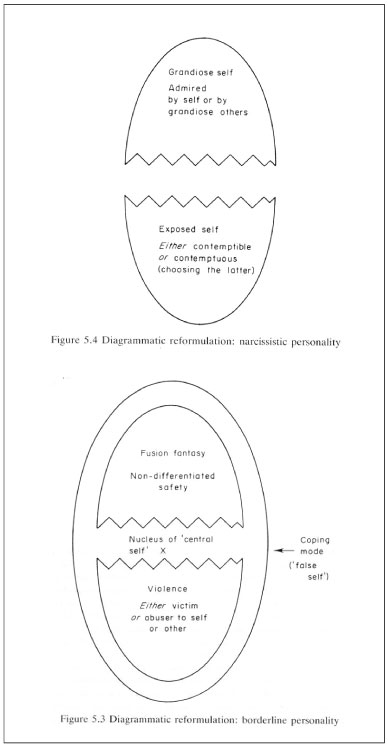
The Borderline Personality Disorder (BDP) Structural Issue
BDP is seen to involve partial dissociation between alternative RRPs. These original, usually Abusing – Abused RRPs, may be re-enacted, but often, faced with evident repetitions, dissociations to alternative, less forbidden patterns may occur (e.g. zombie states, compliant, soldiering on states etc.)
In (Map 6, Ryle 2002, Pg 115) it is possible to see three cores and the implicit flashpoint where dissociation is assumed to have originally occurred; the actual, anticipated or perceived repeat of unmanageable experiences may provoke state switches. The value in supervision is in helping the therapist to locate the flashpoints and to recognise the range of states manifest at different times. The idea of the flashpoint is indicated when the move into unmanageable feelings connected to earlier unmet needs is manifest in the sessions. The diagram allows rapid recognition of the individual’s alternative states.
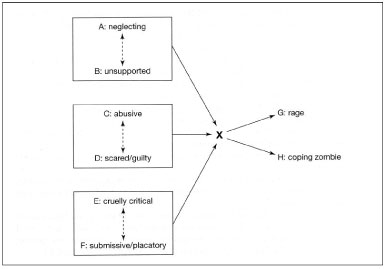
The Self State Sequential Diagrams and Multiple Self States Model
How many cores can be incorporated into a sequence? Leiman’s dialogic sequences can be analysed in terms of shifts between a range of RRPs, rather than through the use of procedural loops. The latter offer a more generalised picture but imply a constant RRP, whereas in practice both changes within self states (role reversals, response shifts) and between self-states may occur with bewildering rapidity – ‘whirlpooling' (Ryle 1997).
It is important to be clear about the distinction between the concepts of states and self-states. A state is a subjective experience; a mood with associated memories, ways of acting and relating etc., such states are always associated with a role, played in relation to another, or to an internalised other. A self-state is an abstraction, our understanding of the structure in Borderline Personality. BPD diagrams describe the RRPs of the different self-states. They are not schemas located in the head, generating procedures. They are our generalisations derived from detailed observations and reports of what the person goes on feeling and doing in relation to others and to the self.
SDRs and Clinical Management
Despite the standardisation of conventions in the making of maps they still remain flexible tools, ones that are designed for use by patients, therapists and in work with other staff. An example of anorexia, its symptoms, acts and staff responses, can be the basis for care planning, staff supervision and all manner of contextual reformulation.
Evidence
Dawn Bennett and Glenys Parry have shown the accuracy of SSSDs by comparing them with standard analyses of therapy sessions (Bennett and Parry 1998). John Bristow has made a study of patient – therapist pairs (Bristow 1997). He showed that patients could be initially shocked, but then helped. Their active involvement with the diagram’s construction and its perceived accuracy was correlated with outcome. Both the therapist’s ability to experience feeling and to stand back was associated with diagram use.
In Summary
The history of the development of SDRs is an important part of the history of CAT. This reflects a two way process. Modifications in SDR technique allowed new aspects of patients to be recognised and thought about e.g. multiple cores and BPD; theoretical ideas influence the SDRs e.g. emphasis on reciprocity and dialogue. Working with patients to construct diagrams with awareness of the central importance of the RRP as a unit and of the dialogic structure whereby every act or statement is directed at another or internalised other, provides CAT therapists with a powerful awareness of their professional role. It is important to remember that there is a need to generalise and summarise. The task is to record the complexity of the individual but to do so in general terms (for example not including relationships with specific others on the diagram) and then to reduce the complexity to create a working tool. Bakhtin said “there is no last word” and we can be sure the development of diagrams has not reached a final conclusion.
References
Bennett, D. and Parry, G. (1998) The accuracy of reformulation in cognitive analytical therapy a validation study. Psychotherapy Research, 8, 402-422.
Bristow, J. (1997) An exploratory study of the effect of the SDR on the outcome of CAT. Some conditions associated with affectiveness. Unpublished research paper.
Bruner, J. (1990) Acts of Meaning. Cambridge, MA:Harvard University Press.
Ryle, A. (1990) Cognitive Analytical Therapy: Active Participation in Change. Chichester: Wiley.
Ryle, A. (1997) Cognitive Analytical Therapy and Borderline Personality Disorder: The Model and the Method. Chichester: Wiley.
Ryle, A. and Kerr, I.B. (2002) Introducing Cognitive Analytic Therapy. Principles and Practice. Chichester: Wiley
Ryle, A. and Beard, H. (1993) British Journal and Medical Psychology, 66, 249. Available in Volume of the collected CAT papers put together by Mark Dunn.
Ryle, A. and Lunghi, M. (1970) The dyad grid: a modification of repertory grid technique. British Journal of Psychiatry, 118, 323-327
 Petition to NHS England - The Case for Funding Training in the NHS 2021
Alert!
Petition to NHS England - The Case for Funding Training in the NHS 2021
Alert!ACAT's online payment system has been updated - click for more information

Full Reference
Ryle, A., 2003. History and Use of the SDR. Reformulation, Autumn, pp.18-21.Search the Bibliography
Type in your search terms. If you want to search for results that match ALL of your keywords you can list them with commas between them; e.g., "borderline,adolescent", which will bring back results that have BOTH keywords mentioned in the title or author data.
Related Articles
The Development of the Sequential Diagrammatic Reformulation
Parkinson, R., 2008. The Development of the Sequential Diagrammatic Reformulation. Reformulation, Summer, pp.33-37.
Sequential Diagrams, Reflections and Suggested Revisions
Ryle, A., 1998. Sequential Diagrams, Reflections and Suggested Revisions. Reformulation, ACAT News Autumn, p.x.
States Characterisation Procedure (SCP) for supporting the reformulation of patients with borderline/dissociative features
Ryle, A., 2007. States Characterisation Procedure (SCP) for supporting the reformulation of patients with borderline/dissociative features. Reformulation, Winter, pp.9-11.
A Brief Introductory Handout About CAT
Blunden, J., 1993. A Brief Introductory Handout About CAT. Reformulation, ACAT News Winter, p.x.
The Special Needs Project (CAT For Borderline Patients)
Ryle, A., 1995. The Special Needs Project (CAT For Borderline Patients). Reformulation, ACAT News Winter, p.x.
Other Articles in the Same Issue
ACATnews: A Fellow Scandinavian's Experience of the CAT Conference in Finland
Burns-Ludgren, E., 2003. ACATnews: A Fellow Scandinavian's Experience of the CAT Conference in Finland. Reformulation, Autumn, p.8.
ACATnews: CAT in Ireland
Parker, I., 2003. ACATnews: CAT in Ireland. Reformulation, Autumn, p.9.
ACATnews: CPD Update
Buckley, M., 2003. ACATnews: CPD Update. Reformulation, Autumn, p.6.
ACATnews: Impressions from the International CAT Conference in Finland, June 2003
Curran, A. and B. Kerr, I., 2003. ACATnews: Impressions from the International CAT Conference in Finland, June 2003. Reformulation, Autumn, p.7.
ACATnews: North-East
Jellema, A., 2003. ACATnews: North-East. Reformulation, Autumn, p.6.
Cultural Diversity and CAT
Toye, J., 2003. Cultural Diversity and CAT. Reformulation, Autumn, pp.25-29.
Developing a Language for the Psychotherapy of Later Life
Hepple, J., 2003. Developing a Language for the Psychotherapy of Later Life. Reformulation, Autumn, pp.10-12.
Editorial
Scott Stewart, M. and Nuttall, S., 2003. Editorial. Reformulation, Autumn, p.2.
History and Use of the SDR
Ryle, A., 2003. History and Use of the SDR. Reformulation, Autumn, pp.18-21.
Letter from the Chair of ACAT
Potter, S., 2003. Letter from the Chair of ACAT. Reformulation, Autumn, pp.33-34.
Letters to the Editors: Agenda for Change and Psychotherapy
Nield, C., 2003. Letters to the Editors: Agenda for Change and Psychotherapy. Reformulation, Autumn, p.3.
Letters to the Editors: Association of Adult Psychotherapists (AAP)
Webster, M., 2003. Letters to the Editors: Association of Adult Psychotherapists (AAP). Reformulation, Autumn, pp.3-4.
Letters to the Editors: Dissertations and Reformulation
Toye, J., 2003. Letters to the Editors: Dissertations and Reformulation. Reformulation, Autumn, p.4.
Letters to the Editors: Psychoanalytic Perspective on Perversion Reformulated
Denman, C., 2003. Letters to the Editors: Psychoanalytic Perspective on Perversion Reformulated. Reformulation, Autumn, pp.4-5.
Mind the Gap
Walsh, M., 2003. Mind the Gap. Reformulation, Autumn, pp.22-24.
The States Description Procedure
Ryle, T., 2003. The States Description Procedure. Reformulation, Autumn, pp.13-16.
Using and Understanding of Primary Process Thinking in CAT
Sacks, M., 2003. Using and Understanding of Primary Process Thinking in CAT. Reformulation, Autumn, pp.30-32.
Help
This site has recently been updated to be Mobile Friendly. We are working through the pages to check everything is working properly. If you spot a problem please email support@acat.me.uk and we'll look into it. Thank you.
